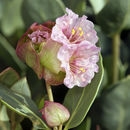Comments
provided by eFloras
Hermidium was once maintained as a genus based on discrete involucral bracts. As discussed by G. E. Pilz (1978), distinct bracts are typical, but involucres with the five outermost bracts united to one-half their length are common.
- license
- cc-by-nc-sa-3.0
- copyright
- Missouri Botanical Garden, 4344 Shaw Boulevard, St. Louis, MO, 63110 USA
Description
provided by eFloras
Herbs, forming hemispheric clumps 6-8 dm diam., glabrous or very sparsely puberulent. Stems 2-4 dm. Leaves spreading; petioles of proximal leaves 0.5-0.7 cm; blades of midstem leaves ovate to widely ovate, 4.5-9 × 3.5-5 cm, base obtuse to rounded, often oblique, apex obtuse, rarely acute. Involucres: peduncle 3-10 mm; involucres erect to pendent, 11-30 mm; bracts 6-9, distinct or to 50% connate, apex acute to obtuse, rarely rounded. Flowers 6-9 per involucre; perianth usually magenta, occasionally creamy white, bell-shaped, 1.5-1.8 cm. Fruits mottled olive green, with 10 slender, tan ribs, ellipsoid, 5.5-7 mm, rugulose, glabrous, secreting thick, heavy mucilage when wetted.
- license
- cc-by-nc-sa-3.0
- copyright
- Missouri Botanical Garden, 4344 Shaw Boulevard, St. Louis, MO, 63110 USA
Distribution
provided by eFloras
Calif., Colo., Nev., Utah.
- license
- cc-by-nc-sa-3.0
- copyright
- Missouri Botanical Garden, 4344 Shaw Boulevard, St. Louis, MO, 63110 USA
Flowering/Fruiting
provided by eFloras
Flowering spring-late summer.
- license
- cc-by-nc-sa-3.0
- copyright
- Missouri Botanical Garden, 4344 Shaw Boulevard, St. Louis, MO, 63110 USA
Habitat
provided by eFloras
Gravelly or sandy soils in arid brushlands or pinyon-juniper woodlands; 1200-2000m.
- license
- cc-by-nc-sa-3.0
- copyright
- Missouri Botanical Garden, 4344 Shaw Boulevard, St. Louis, MO, 63110 USA
Synonym
provided by eFloras
Hermidium alipes S. Watson, Botany (Fortieth Parallel), 286, plate 32. 1871; H. alipes var. pallidium Ch. Porter
- license
- cc-by-nc-sa-3.0
- copyright
- Missouri Botanical Garden, 4344 Shaw Boulevard, St. Louis, MO, 63110 USA
Comprehensive Description
provided by North American Flora
Hermidium alipes S. Wats. Bot. King's Expl. 286. 1871
Plants 2-4 dm. high, the stems arcuate-ascending, sparsely branched, the branches very stout, glaucous, glabrous, or obscurely puberulent above; petioles stout, 2-12 mm. long; leafblades orbicular-ovate, suborbicular, or broadly oval-ovate, 4-7 cm. long, 2-5.5 cm. wide, often as broad as long, rounded to obtuse at the base or rarely subcordate, often short-decurrent, obtuse to broadly rounded and apiculate at the apex, or the uppermost acu,te, green, thick and succulent, with rather prominent lateral nerves, glabrous; flowers in heads of usually 6, these on peduncles 3-10 mm. long, the peduncles at' first minutely puberulent but soon glabrate; bracts oblong to broadly ovate, 1.5—2.5 cm. long, subcordate or rounded at the base, rounded or obtuse at the apex and often apiculate, rarely slightly united at the base, thin, glabrous, often tinged with red; perianth 2 cm. long, the limb about 1.7 cm. broad, glabrous; stamens equaling or slightly shorter than the perianth; fruit 7 mm. long, 3.5-4 mm. diameter, slightly narrowed at both ends, dark-olive.
Type locality: On low foothills from the Big Bend of the Truckee River to Oreana on the Humboldt, Nevada.
Distribution: Western Nevada and adjacent California.
- bibliographic citation
- Paul Carpenter Standley. 1918. (CHENOPODIALES); ALLIONIACEAE. North American flora. vol 21(3). New York Botanical Garden, New York, NY
Mirabilis alipes: Brief Summary
provided by wikipedia EN
Mirabilis alipes is a species of flowering plant in the four o'clock family known by the common name winged four o'clock. It is native to the southwestern United States from eastern California to western Colorado, where it grows in brush, woodland, and dry mountain slope habitat. It is a perennial herb growing in a clump near 40 centimetres (15+3⁄4 in) tall and up to 80 centimetres (31+1⁄2 in) wide. The leaves are oppositely arranged on the spreading stem branches. Each fleshy leaf has an oval or rounded blade up to 7 to 9 centimetres (2+3⁄4 to 3+1⁄2 in) long and is hairless or sparsely hairy. The flowers occur in leaf axils on the upper branches. Five to nine flowers bloom from a cup-shaped involucre of several partly fused bracts. Each five-lobed flower is about 1.5 centimetres (5⁄8 in) wide and magenta in color; cream-colored flowers are also known.
- license
- cc-by-sa-3.0
- copyright
- Wikipedia authors and editors

